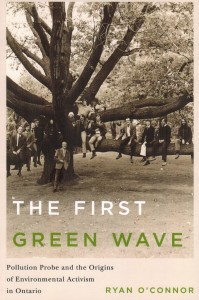Canadians of a certain vintage can still recall when DDT was found in every kitchen cupboard and it was considered eccentric not to throw candy wrappings out the car window. The Ontario Department of Highways used to spend $1 million a year clearing roadside litter.
This did not change by osmosis. It took years of litigation and dramatic protest by a comparatively few people. “It was a burn-out job but you loved it,” one organizer tells author Ryan O’Connor. “It was what needed to be done so you did it.”
O’Connor’s First Green Wave chronicles the birth of environmental activism in Canada. It is a fresh account of Pollution Probe, a citizens’ committee that grew from the University of Toronto to include chapters from Halifax to Regina. Pollution Probe was never a mass movement; its membership peaked at some 1,500. The Kinsmen Club had 16,000. Yet its impact was far-reaching.
It launched the first recycling drive of its kind, a 1971 campaign to collect a million discarded Toronto telephone directories. It created the Canadian Environmental Law Association in 1972, still indispensable after all these years. It warned Canadians we were poisoning our lakes and streams – a phenomenon dramatized when Lake Erie’s Cuyahoga River caught on fire in 1969.
“One of the impressive things was they couldn’t be dismissed as sort of hairy radicals,” one U of T faculty member tells O’Connor. “They were all so conformist looking.” Pollution Probe organizers had neat haircuts and wore ties and knew how to write a press release.
O’Connor, a research associate at Trent University, traces environmental activism in this country from a TV documentary, a 1967 CBC film called Air Of Death. There were earlier attempts, of course: U.S. author Rachel Carson’s 1962 work Silent Spring made Canadian bestseller lists and a 1960 National Film Board production Poisons, Pests & People savaged the use of farm pesticides, but was withdrawn from distribution amid industry protest.
Air Of Death was more dramatic. It preempted the Ed Sullivan Show, drawing a national audience of 1.5 million. The documentary chronicled the poisoning of crops and cattle by a phosphate plant near Dunville, Ont. on Lake Erie. “Something mysterious burned the peppers, burned the fruit, dwarfed and shriveled the grains,” filmmakers reported; “Cattle lie down and die.” The poison was fluorine. The plant’s operator, Electric Reduction Co., quietly paid out $198,000 in damages to nearby farmers, the equivalent of $1.3 million today.
“Every day your lungs inhale fifteen thousand quarts of air and poison,” viewers were told. “Death has been gathering in the air in every Canadian city.” The documentary would be startling even if broadcast today. In 1967 it was hypnotic.
O’Connor credits the film with inspiring an entire generation of publicity-wise Canadian activists. Their work had such an impact that by 1970 the leader of the federal Progressive Conservative party made sure to be photographed wearing a Pollution Probe button.
The First Green Wave is lively and provocative, nostalgic and compelling. Professor O’Connor recounts the words of Toronto’s parks superintendent, caught sanctioning the use of pesticides so lethal they killed mallards that washed up on a Lake Ontario beach. “It’s either that or have the trees dying and people getting covered in slimy caterpillars,” he said.
By Holly Doan
The First Green Wave: Pollution Probe & The Origins Of Environmental Activism In Ontario, by Ryan O’Connor; University of British Columbia Press; 264 pages; ISBN 9780-7748-28093; $29.95






